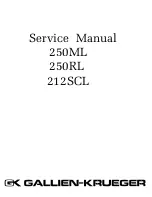
Philips Semiconductors
AN<nnnnn>
TDA1562Q application note
<12NC>
© Koninklijke Philips Electronics N.V. 2004. All rights reserved.
Application note
Rev. 01.02 — 05 May 2006
39 of 62
slightly due to the onset of clipping. The voltage across the load remains a perfect
sinewave shape.
When the input signal is increased further, the output signals will look as in figure 24. The
bottom parts of the sinewaves are clipping heavily and the tops of the sinewaves are
extended. Across the load, however, the signal is still a sinewave.
Fig 25. Waveforms during clipping (f=1kHz)
Finally, when the input level is increased even more, the tops of the output waveforms
will also start clipping. When this level is reached, the signal across the load will also
start clipping, as is illustrated in fig. 25.
At low signal frequencies the tops of a clipping signal will slope down (fig. 26).
This sloping down of the signal is caused by the energy being “drained” from the lift
capacitors. As long as not too much energy is drained from the lift capacitors, the voltage
will be sustained. At low signal frequencies, much energy is drained from the lift
capacitors, which will cause the voltage across the lift capacitors to decrease.
When the amplifier is driven into clipping at very low frequencies, it may happen that the
lift capacitors are fully drained. In such a situation the lift capacitors will remain
discharged as long as the input signal is high, since there is only very little time for
recharging. The amplifier will then deliver the same output power as a normal class AB
amplifier would. As soon as the signal drops below the level where the outputs are lifted,
the lift capacitors will be recharged and the amplifier will be able to deliver its full output
power again.
OUT 1
OUT 2
Vload
















































